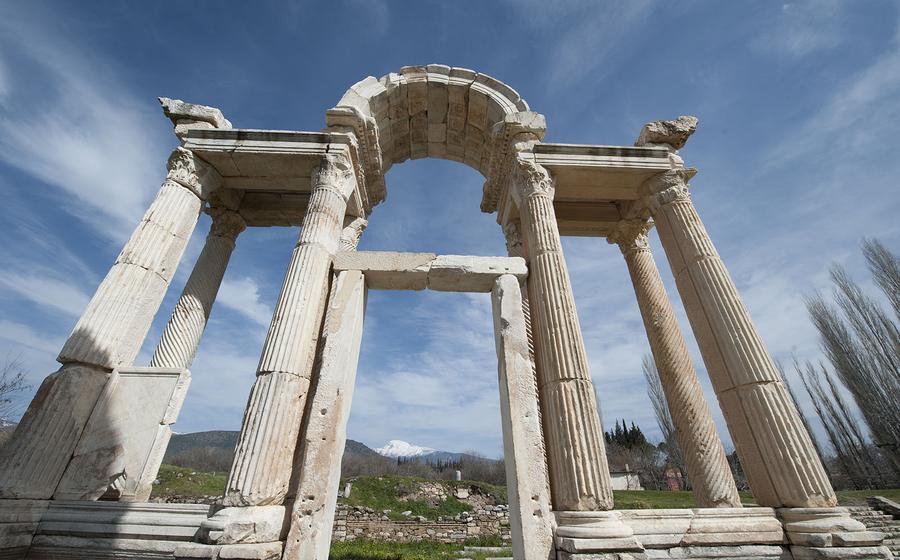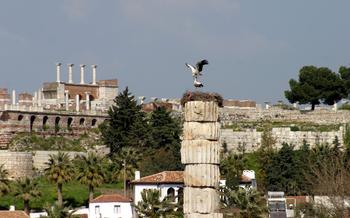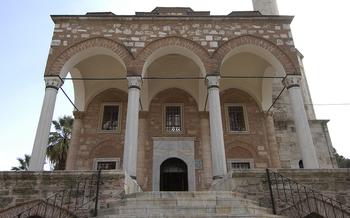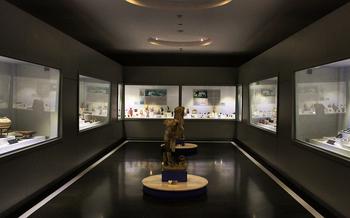
Temple of Artemis
- A Journey to Ancient Wonder: Unveiling the Temple of Artemis
- Excavating the Past: Archaeological Discoveries at the Temple
- Tracing the Temple's Origins: Historical Context and Construction
- Architectural Grandeur: Exploring the Temple's Design and Features
- Witnessing the Power of Nature: The Temple's Destruction and Legacy
- Preserving the Past: Conservation Efforts at the Temple Site
- Exploring the Temple's Surroundings: Ephesus and Beyond
- Finding Your Way: Getting to the Temple of Artemis
- Steeped in History: The Temple of Artemis Museum
- A Photographic Journey: Capturing the Temple's Beauty
- Ancient Echoes: The Temple's Enduring Legacy
- Planning Your Visit: Practical Tips for a Memorable Experience
- Unveiling Local Treasures: Exploring Aydın's Hidden Gems
A Journey to Ancient Wonder: Unveiling the Temple of Artemis
The Temple of Artemis, one of the Seven Wonders of the Ancient World, stands as a testament to the grandeur and splendor of the ancient city of Ephesus. Recognized as a UNESCO World Heritage Site, this architectural marvel captivates visitors with its awe-inspiring presence. The temple's design, a masterpiece of Hellenistic architecture, showcases the remarkable engineering and artistic achievements of the ancient Greeks. Its towering columns, intricate sculptures, and harmonious proportions have left an indelible mark on the world of architecture, influencing countless structures throughout history. As you step into the ruins of this ancient sanctuary, prepare to be transported back in time, where myth and history intertwine, revealing the essence of a civilization that left an enduring legacy on the world.
Excavating the Past: Archaeological Discoveries at the Temple
Archaeological excavations at the Temple of Artemis have shed light on its rich history and significance. Beginning in the late 19th century, excavations led by British and Austrian archaeologists unearthed a wealth of artifacts, including sculptures, inscriptions, and architectural fragments. These discoveries provided valuable insights into the temple's construction, design, and religious practices.
Among the most notable finds were the remains of the temple's colossal statue of Artemis, which once stood over 15 meters tall. The statue, carved from ivory and gold, was considered one of the most impressive works of ancient Greek art. Other significant discoveries included inscriptions detailing the temple's construction and renovation, as well as votive offerings left by worshippers.
Current excavations at the site, conducted by Turkish archaeologists, continue to uncover new and exciting finds. Recent discoveries include a well-preserved section of the temple's marble pavement and a series of underground chambers that may have been used for religious rituals. These ongoing excavations promise to reveal even more about the temple's history and significance, providing valuable insights into the ancient world.
Tracing the Temple's Origins: Historical Context and Construction
The Temple of Artemis was constructed during a period of significant cultural and political transformation in the ancient world. The region of Ionia, where Ephesus was located, had long been a melting pot of cultures, with influences from Greece, Persia, and Lydia converging to create a unique blend of artistic and architectural styles.
The construction of the temple is shrouded in a veil of myth and legend. According to one account, the temple was built by the Amazons, a mythical tribe of warrior women who were said to have founded Ephesus. Another legend attributes the temple's construction to Androclus, the son of the Athenian king Codrus, who is said to have led a group of colonists to Ephesus in the 11th century BC.
The historical records suggest that the temple was built over a period of several centuries, with contributions from various rulers and benefactors. The initial construction phase is believed to have begun in the 7th century BC, under the patronage of the Lydian king Croesus. The temple was later expanded and embellished by the Greek rulers of Ephesus, including Alexander the Great and his successors.
The construction of the temple involved a combination of local and imported materials. The massive columns that supported the temple's roof were made from marble quarried on the island of Samos, while the roof tiles were made from a special type of clay that was found in the vicinity of Ephesus. The temple's sculptures and decorations were carved from a variety of materials, including marble, limestone, and bronze.
Architectural Grandeur: Exploring the Temple's Design and Features
The Temple of Artemis, renowned for its architectural magnificence, stood as a testament to the ingenuity and artistry of the ancient Greeks. Its colossal dimensions, measuring approximately 135 meters in length and 65 meters in width, commanded awe and admiration. The temple's orientation, carefully aligned with the cardinal points, showcased the Greeks' understanding of astronomy and their reverence for celestial bodies.
The exterior of the temple was adorned with a double row of imposing columns, each standing at an impressive height of 18 meters. These columns, crafted from gleaming white marble, featured intricate carvings and delicate fluting, adding to the temple's overall grandeur. The pediments, positioned at the triangular gables above the columns, showcased exquisite sculptures depicting mythological scenes and figures, further enhancing the temple's visual splendor.
The temple's interior, though largely in ruins today, once housed a colossal statue of the goddess Artemis, carved from gold and ivory. This awe-inspiring statue, reaching a height of approximately 15 meters, was a masterpiece of ancient craftsmanship and a symbol of the goddess's power and majesty. The cella, or inner chamber, was adorned with intricate decorations, including reliefs and paintings depicting scenes from Greek mythology, adding to the temple's sacred and opulent atmosphere.
The architectural style of the Temple of Artemis exemplified the transition from the Archaic to the Classical period in Greek architecture. Its harmonious proportions, symmetrical design, and emphasis on balance and order served as a model for subsequent architectural developments. The temple's influence can be seen in numerous ancient Greek and Roman structures, demonstrating its lasting impact on the evolution of architectural styles.
Witnessing the Power of Nature: The Temple's Destruction and Legacy
The Temple of Artemis, once a symbol of architectural grandeur and religious devotion, eventually succumbed to the relentless forces of nature. A series of earthquakes, coupled with the ravages of time and neglect, brought about its downfall. Ancient sources provide vivid accounts of the temple's decline, describing how its once-magnificent columns crumbled and its intricate sculptures were reduced to rubble.
The temple's destruction had a profound impact on the ancient city of Ephesus. As one of its most iconic landmarks, the temple's demise symbolized the waning power and influence of the city. The loss of this architectural marvel also marked the end of an era, as Ephesus transitioned from a thriving metropolis to a fading shadow of its former glory.
Despite its physical destruction, the Temple of Artemis continued to live on in the collective memory of the ancient world. Its grandeur and significance were such that even in ruins, it remained a potent symbol of ancient civilization. The temple's legacy extended far beyond its physical remains, inspiring artists, architects, and historians for centuries to come.
Preserving the Past: Conservation Efforts at the Temple Site
The ruins of the Temple of Artemis have stood the test of time, yet they remain vulnerable to the ravages of nature and human impact. Conservation efforts are paramount to safeguarding this ancient wonder for future generations.
Archaeologists, conservators, and historians collaborate to meticulously document, restore, and protect the temple's remains. Techniques such as stone consolidation, structural reinforcement, and excavation are employed to stabilize and preserve the site.
Challenges abound in the preservation process. Natural phenomena like earthquakes, erosion, and weathering pose significant threats. Human activities, such as uncontrolled tourism and development, can also contribute to the site's degradation.
To mitigate these risks, authorities have implemented strict regulations to control access, limit foot traffic, and prevent further damage. Ongoing monitoring and maintenance programs are in place to identify and address potential issues promptly.
The preservation of the Temple of Artemis extends beyond physical restoration. It encompasses the safeguarding of its intangible heritage – the stories, myths, and legends that have shaped its significance. Through education, outreach programs, and digital initiatives, the temple's legacy is disseminated to a global audience, ensuring its enduring place in the annals of history.
Exploring the Temple's Surroundings: Ephesus and Beyond
The Temple of Artemis was not just an isolated structure; it was part of a vibrant ancient city that teemed with life and activity. A visit to the temple offers a unique opportunity to explore not only this magnificent structure but also the surrounding city of Ephesus and the wider region.
Ephesus, a City of Wonders:
Just a short walk from the Temple of Artemis lies the ancient city of Ephesus, one of the best-preserved and most impressive archaeological sites in the world. Wander through its cobbled streets and marvel at the ruins of temples, theaters, libraries, and marketplaces. Highlights include the Library of Celsus, the Great Theater, and the Terrace Houses, which offer a glimpse into the daily lives of the city's inhabitants.
Natural Beauty and Historical Sites:
Beyond Ephesus, the Aydın region is home to a wealth of natural and historical attractions. Take a day trip to the stunning beaches of Pamucak or explore the nearby Dilek Peninsula National Park, with its lush forests, secluded coves, and hiking trails. Visit the ancient city of Priene, with its well-preserved theater and agora, or marvel at the rock-cut tombs of Metropolis.
A Culinary Adventure:
No visit to Aydın would be complete without sampling the region's delicious cuisine. Indulge in traditional Turkish dishes such as gözleme (stuffed flatbread), keşkek (a hearty wheat and meat dish), and keşküllü (a sweet dessert made with shredded wheat and clotted cream).
Creating a Comprehensive Itinerary:
To make the most of your visit, plan a comprehensive itinerary that allows you to explore the Temple of Artemis, Ephesus, and the surrounding region. Allocate at least half a day to explore the temple ruins and the adjacent archaeological museum. Dedicate another day to wandering through the ancient city of Ephesus and visiting the nearby sites of the House of the Virgin Mary and the Temple of Artemis at Sardis. Consider renting a car or joining a guided tour to explore the wider region and discover its hidden gems.
Finding Your Way: Getting to the Temple of Artemis
Reaching the Temple of Artemis is a journey that transports you back in time. From major cities like Izmir, you can embark on a scenic bus ride through the picturesque countryside, enjoying the rolling hills and olive groves that define the region. Trains also offer a convenient option, connecting you to the nearby town of Selçuk, which serves as the gateway to the ancient city of Ephesus.
Once in Selçuk, you can immerse yourself in the town's charm before embarking on a short walk or taking a local taxi to the temple site. The walk takes you through narrow cobblestone streets, lined with traditional Turkish houses and shops selling local handicrafts. Along the way, you can admire the town's historic mosque and other architectural gems that hint at the rich cultural heritage of the region.
For those seeking a more comprehensive experience, organized tours and guided excursions are readily available. These tours often include transportation from major cities, as well as informative commentary from knowledgeable guides who can provide insights into the history and significance of the temple. By joining a guided tour, you can maximize your visit and gain a deeper understanding of this ancient wonder.
Steeped in History: The Temple of Artemis Museum
Housed within the archaeological site of the Temple of Artemis, the Temple of Artemis Museum stands as a testament to the temple's rich history and enduring legacy. Step inside this treasure trove of artifacts and immerse yourself in the captivating world of ancient Greece. The museum's collection boasts an array of fascinating relics, including sculptures, inscriptions, and architectural fragments that once adorned the temple.
Discover intricate sculptures depicting the goddess Artemis, her twin brother Apollo, and other deities of the Greek pantheon. Marvel at the intricate carvings and reliefs that once graced the temple's pediments and friezes, showcasing the exceptional craftsmanship of ancient artisans. Among the highlights of the collection is a colossal statue of Artemis, a testament to the grandeur and majesty of the temple's former glory.
Through these artifacts, the museum provides a glimpse into the religious practices, rituals, and ceremonies that took place within the temple walls. Inscriptions and dedications offer insights into the lives of the people who worshipped here and the significance of the temple in the ancient world.
Visiting the Temple of Artemis Museum is an essential complement to exploring the temple ruins themselves. Here, you can delve deeper into the history, mythology, and cultural significance of this ancient wonder. The museum's exhibits provide a tangible connection to the past, allowing you to appreciate the enduring legacy of the Temple of Artemis and its profound impact on the ancient world.
A Photographic Journey: Capturing the Temple's Beauty
The Temple of Artemis, with its iconic ruins and majestic presence, presents a captivating subject for photography enthusiasts. To capture the temple's beauty and grandeur in your lens, here are some tips to guide you:
-
Golden Hours Magic: Plan your visit during the golden hours, around sunrise or sunset, when the warm light casts a magical glow on the temple ruins. This soft, diffused light enhances the temple's textures and creates stunning contrasts.
-
Experiment with Angles: Explore different angles and perspectives to showcase the temple's unique features. Move around the site to find interesting compositions that highlight the temple's columns, pediments, or sculptures from various viewpoints.
-
Capture the Details: Don't just focus on wide-angle shots. Take the time to capture close-ups of the intricate carvings, inscriptions, and architectural details that adorn the temple. These details add depth and character to your photographs.
-
Play with Shadows: Utilize the play of shadows to create dramatic effects in your images. Harsh midday sunlight can create harsh shadows, but in the early morning or late afternoon, the shadows become softer and more defined, adding depth and texture to your shots.
-
Tripod for Stability: Bring a sturdy tripod to ensure sharp and steady images. This is especially important when shooting in low-light conditions or when using slow shutter speeds to capture the temple's motion blur.
-
Embrace the Elements: Don't let weather conditions deter you. Rain or clouds can create atmospheric shots with moody skies adding drama to your compositions. Embrace the elements and capture the temple in different weather conditions to showcase its diverse beauty.
-
Be Patient: Patience is key to capturing the perfect shot. Sometimes, the best moments happen when you least expect them. Be patient and wait for the right light, the right angle, or the right moment when the temple reveals its hidden beauty.
Ancient Echoes: The Temple's Enduring Legacy
The Temple of Artemis left an indelible mark on the ancient world, its legacy reverberating through art, architecture, culture, and religious practices. Its architectural grandeur inspired countless subsequent structures, becoming a prototype for many other temples and public buildings throughout the Hellenistic world. The temple's iconic columns, pediments, and sculptures provided a model for later architectural developments, influencing the evolution of classical and Roman architecture.
Beyond its architectural impact, the Temple of Artemis held profound religious significance. As a sanctuary dedicated to the goddess Artemis, it played a central role in ancient Greek mythology and religious practices. The temple was a place of pilgrimage, where people from across the region came to worship Artemis and seek her blessings. Its destruction marked a significant loss not only for the city of Ephesus but also for the entire ancient world.
The legacy of the Temple of Artemis extends to the present day. Its ruins remain a testament to the skill and artistry of the ancient Greeks, attracting visitors from around the world. The temple's enduring significance lies in its embodiment of ancient civilization, its architectural prowess, and its religious and cultural importance. It serves as a reminder of the enduring power of human creativity and the profound impact that ancient monuments can have on shaping our understanding of the past.
Planning Your Visit: Practical Tips for a Memorable Experience
To ensure a seamless and enriching visit to the Temple of Artemis, meticulous planning is essential. The temple is generally open to the public daily, offering ample opportunities for exploration and discovery. Ticket prices are reasonable, allowing for accessible entry. Guided tours are available for those seeking a more immersive experience, providing insights and historical context from expert guides.
When planning your visit, consider the time of year to optimize your experience. The ideal period to visit is during the shoulder seasons, spring (April-May) and autumn (September-October), when the weather is pleasant, and the crowds are smaller. During the summer months (June-August), temperatures can soar, making exploration less comfortable, and the site can be more crowded with tourists.
To fully appreciate the grandeur of the temple and its surroundings, allocate sufficient time for your visit. Allow at least two to three hours to explore the site at a leisurely pace, taking in the architectural details, immersing yourself in the history, and capturing the beauty of the ruins through photographs.
While exploring the temple, ensure you wear comfortable footwear suitable for uneven terrain, as the site involves some walking on ancient cobblestone paths. Sun protection is also essential, particularly during the summer months, as shade is limited within the ruins. Consider bringing a hat, sunglasses, and sunscreen to protect yourself from the sun's intensity.
To enhance your visit, combine your exploration of the temple with other nearby attractions in the Aydın region. The ancient city of Ephesus, with its impressive ruins and well-preserved structures, is a must-visit destination, offering a glimpse into the grandeur of the ancient world. The nearby town of Selçuk also boasts historical and cultural treasures, including the Basilica of St. John and the İsa Bey Mosque, providing a fascinating blend of Byzantine and Ottoman architecture.
Unveiling Local Treasures: Exploring Aydın's Hidden Gems
A visit to the Temple of Artemis offers a gateway to exploring the hidden treasures of the Aydın region. Beyond the ancient ruins, Aydın boasts a rich tapestry of cultural and historical attractions waiting to be discovered.
Journey to the ancient city of Tralles, where impressive Hellenistic and Roman ruins, including a well-preserved theater, transport you back in time. Immerse yourself in the vibrant colors and intricate patterns of traditional Turkish carpets at the Aydın Carpet Museum, a testament to the region's rich textile heritage.
Explore the natural wonders that surround Aydın. Bask in the sun-soaked beaches of Didim, where turquoise waters and golden sands create a picturesque paradise. Ascend the majestic Mount Bozdağ, the highest peak in the Aegean Region, and marvel at the breathtaking views that stretch for miles. Discover the enchanting Lake Bafa Nature Park, a haven for diverse wildlife and a sanctuary for migratory birds.
Indulge in the culinary delights of Aydın's traditional cuisine. Savor the flavors of keşkek, a hearty dish made from bulgur and meat, or tantalize your taste buds with the region's famous olives and olive oil, renowned for their exceptional quality.
Venture off the beaten path and uncover hidden gems that reveal the authentic charm of Aydın. Explore the quaint villages nestled amidst lush green valleys, where time seems to stand still. Engage with the friendly locals, who are always eager to share stories and insights into their way of life.
Let Aydın captivate you with its rich cultural heritage, stunning natural landscapes, and warm hospitality. Embark on a journey that goes beyond the Temple of Artemis, and discover the hidden treasures that make this region a true gem of Turkey.









